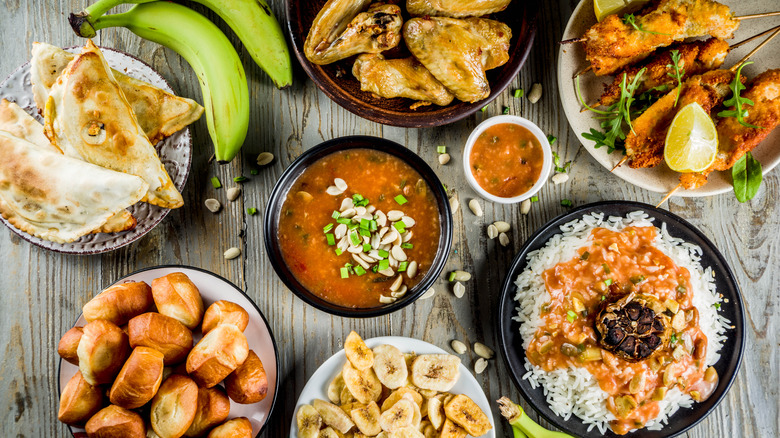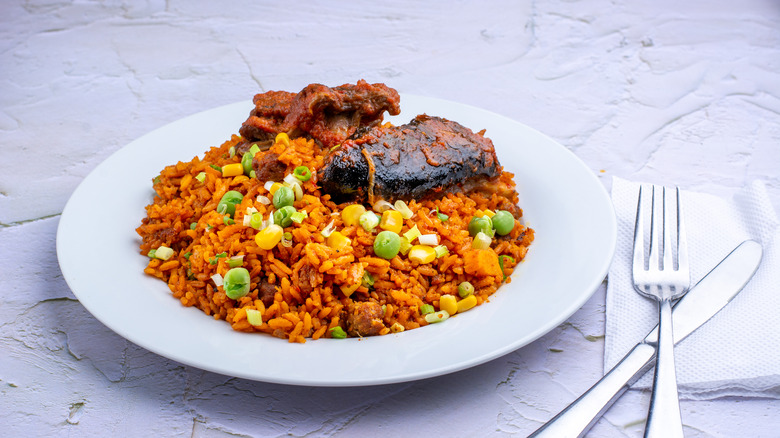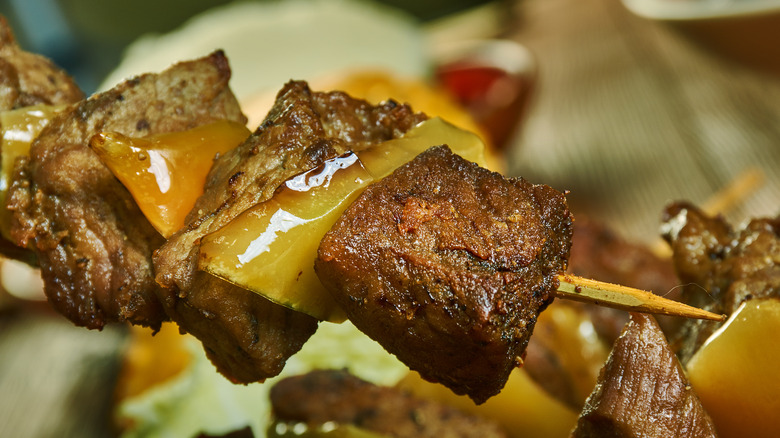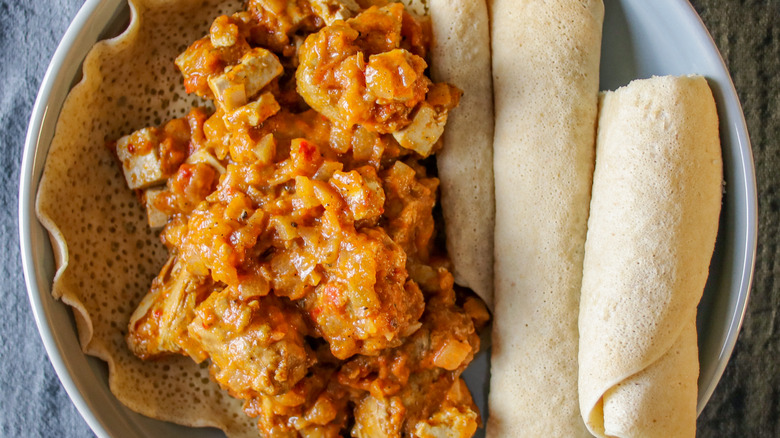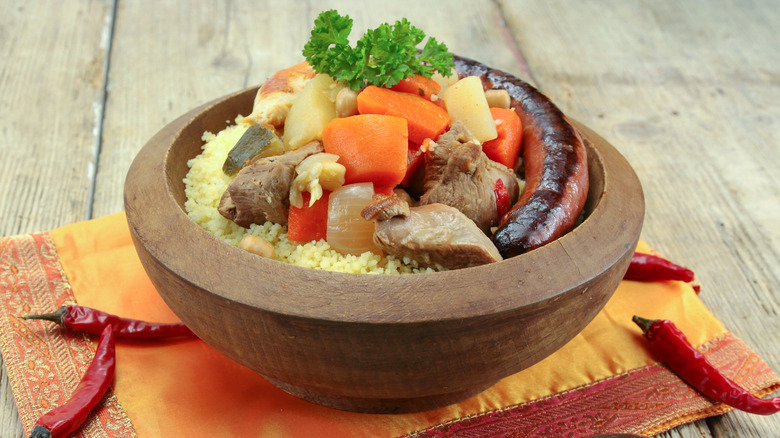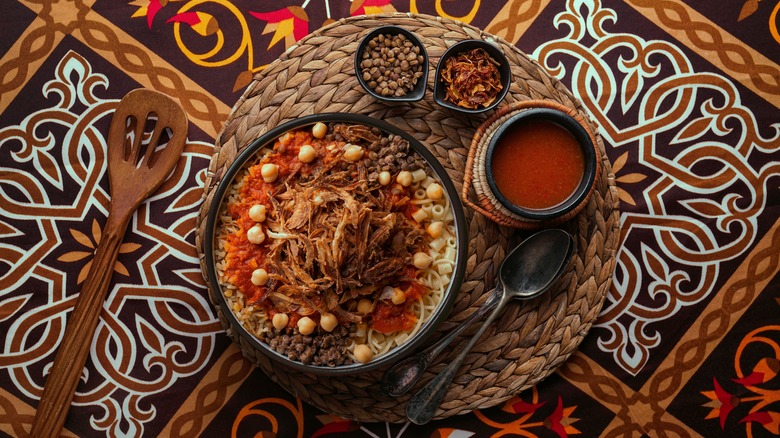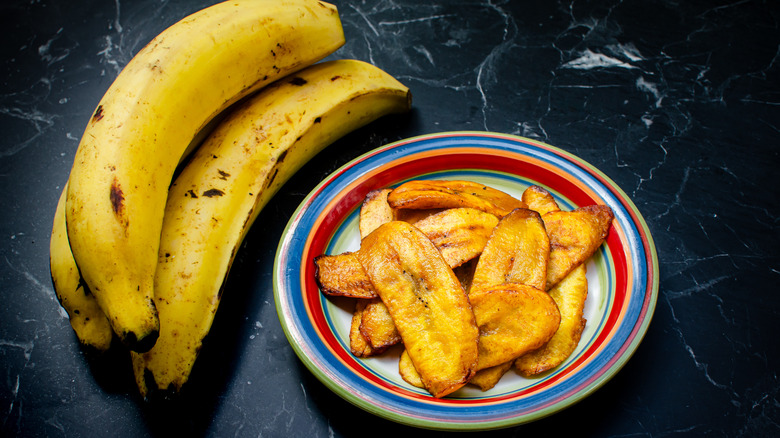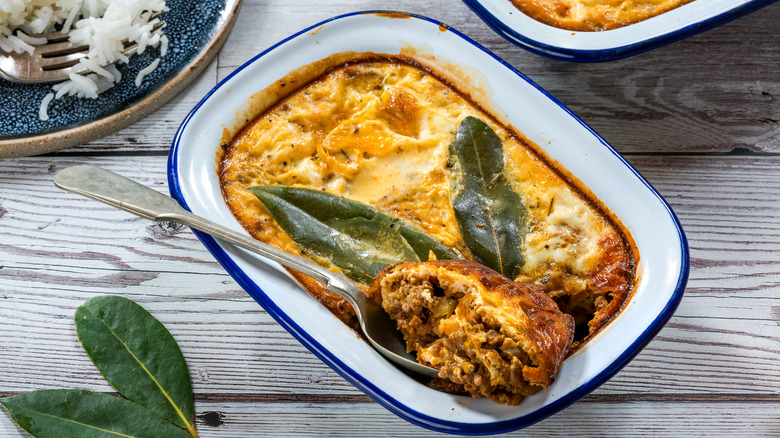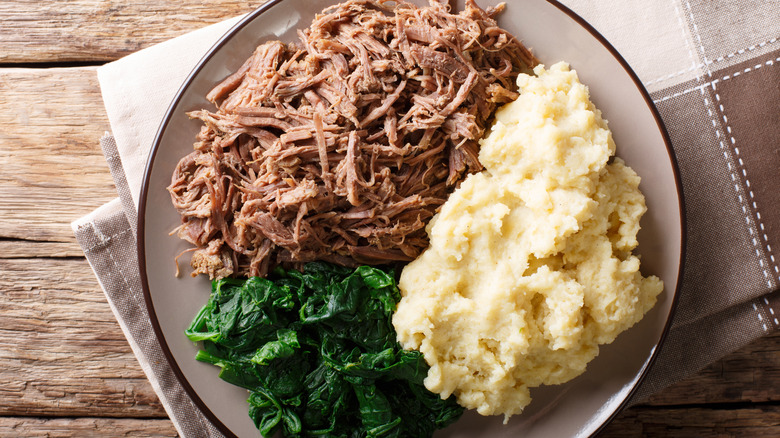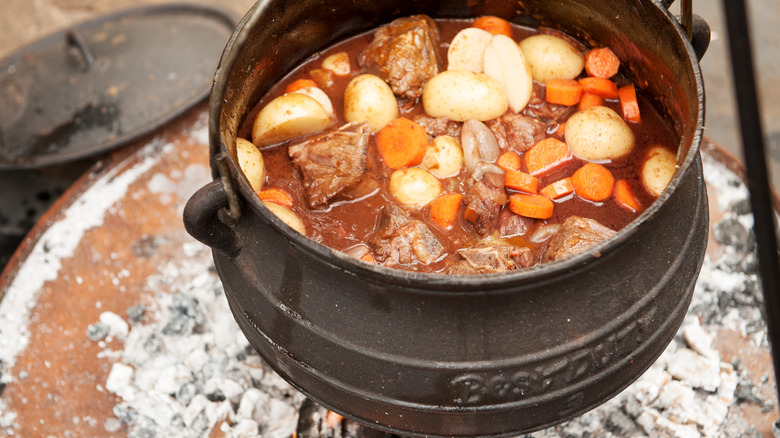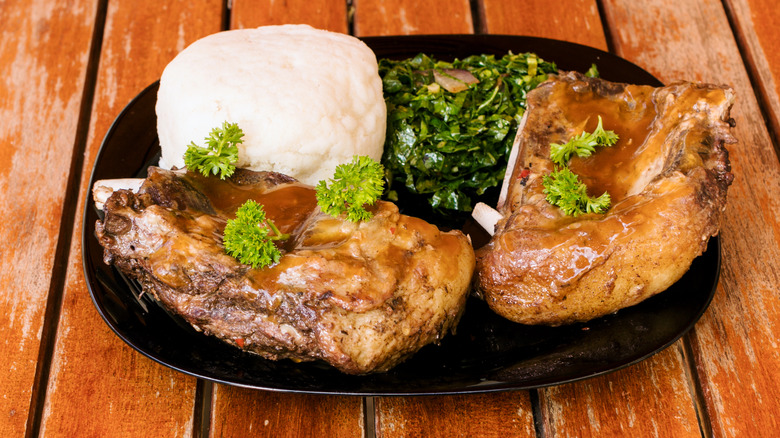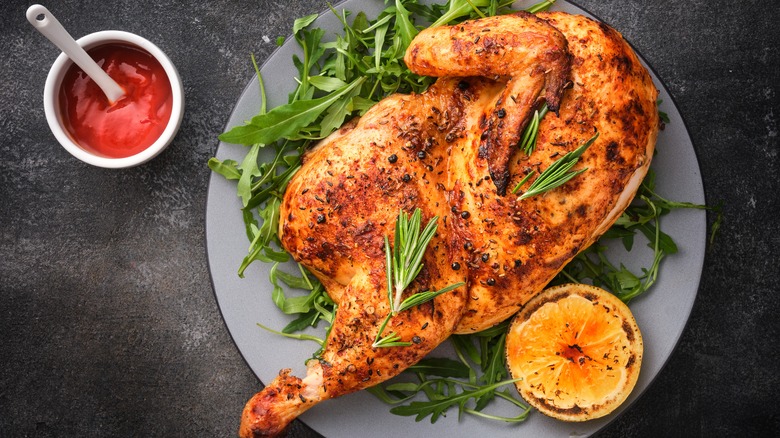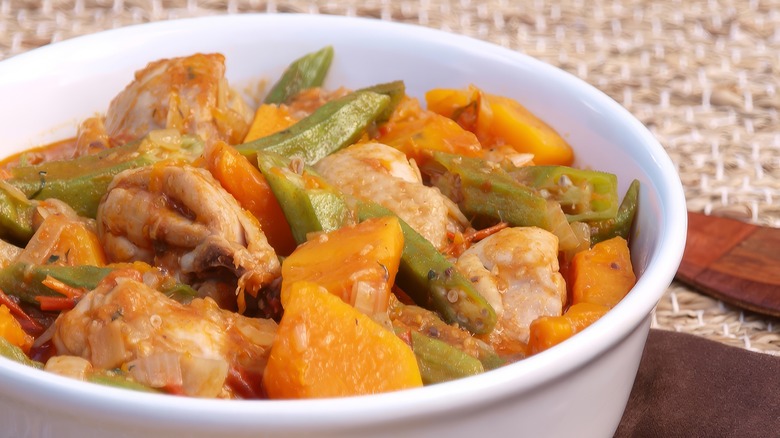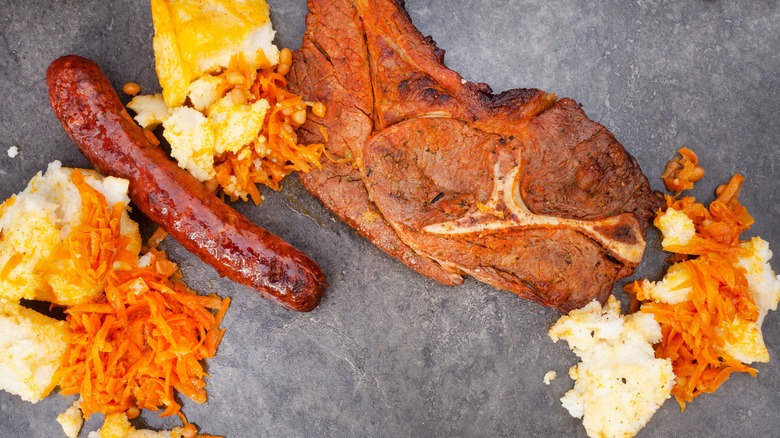13 Iconic African Foods You Have To Try Before You Die
Most people will not deny that food is one of the most significant markers of a culture and its people. However, when it comes to the global banquet table, some regions are more easily relegated to the margins — this can often be said for Africa. The importance of food and its relationship to a people's traditions and heritage cannot be understated. Whether the food facilitates connection, is related to a story of historical, political, or religious evolution, is consumed in spaces of mourning or celebrating, or is simply used as sustenance, it is an essential component of culture. Read on to find some of the most delicious African foods you have to try before you die. (And remember that African cuisine has had an undeniable influence on soul food in the U.S. South, too.)
In order to map out some of the most iconic foods across the continent, it is important to highlight that the continent consists of five regions, namely: Northern, Western, Eastern, Southern, and Central Africa. Countries in the same region often share some elements of historic, cultural, and culinary heritage, with some differences coming down to minor variations in ingredients or methods of preparation.
1. Jollof Rice (Western Africa)
When it comes to iconic African foods, it is quite possible that none descend into debate as quickly as Jollof rice. Traditionally a West African dish, Jollof rice has various renditions depending on the country in which it is made, chief among them being Ghana, Nigeria, and Senegal. Each proudly claims that their version is of far higher quality than their counterparts. As for which country takes ownership of its origin? That too will spark debate. Nevertheless, Jollof's rise to prominence has been linked to the ancient Wolof Kingdom that ruled West Africa in the 14th century. It was initially called thieboudienne (a rice dish that included vegetables, fish, and shellfish). However, thieboudienne began to evolve when the French introduced broken rice from the Indochina region during its colonial rule between 1860 and 1940, replacing indigenous crops.
Today, Jollof mainly consists of rice cooked with a spicy tomato sauce that is stratified with ingredients including tomato puree, garlic, ginger, thyme, selim (a popular West African spice), and Scotch bonnet chilies. While the preparation and the composition of these ingredients will differ based on nationality, the dish remains a popular staple at weddings, parties, and other ceremonies, and can be served with fried plantain and various types of meat, including beef and goat.
2. Mshikaki (Tanzania, Eastern Africa)
Mshikaki is a popular East African dish that dates back thousands of years and is popularly found in Tanzania. Essentially a dish of skewered meat, mshikaki can be roasted or grilled and is comprised of various types of meat including beef, chicken, and goat. The meat is usually seasoned with a mix of chili powder, ginger, masala, garlic, tomato puree, oil, salt, and pepper.
Mshikaki is particularly popular because it is easy to eat on the go. One can often find it available at outdoor markets and from roadside traders while going about their day, thus making it incredibly accessible — whether as a snack or as part of a main dish. Overall, the art of making mshikaki has continued to evolve across the ages, and while there are various renditions of the Tanzanian dish across the globe today, its preparation is often likened to Nyama Choma, from Kenya, and it's similar in appearance to Yakitori, from Japan.
3. Doro Wat (Ethiopia, Eastern Africa)
Doro wat is an Ethiopian chicken stew that draws inspiration from the country's mix of both Arab and African traditions. A staple that can be found in almost every restaurant across the country, Doro wat has a distinct taste thanks to berbere, the popular North African spice blend. Often enjoyed communally, it is typically served with a healthy portion of injera, a teff-based flatbread that is used to scoop the stew, which is prepared only after the batter has undergone a three-day fermentation process.
This iconic Ethiopian stew mainly draws its flavor from the berbere spice blend, which includes fragrant aromatics like cardamom, cloves, and fenugreek. A key point to highlight is that this dish takes time and should not be rushed. Tomato paste, onions, garlic, ginger, and vinegar are often added during the slow cooking process to layer in the flavors. Once ready, hard-boiled eggs often top off the dish, and then it is served.
4. Couscous Royale (Tunisia, Northern Africa)
A popular dish in Algeria, Libya, Morocco, and Tunisia, couscous royale is a traditional meal that was created by the Berber (Amazigh) people of Algeria and Morocco. Its origins can be traced back to some point between the fall of the Zirid dynasty during the 11th century and the rise of the Almohad Caliphate during the 13th century. Notably though, today it is considered to be the official national dish of Tunisia, even though different versions of the dish will be found in the aforementioned countries of Northern Africa.
Today, this dish is essentially fluffy couscous topped with meatballs, merguez sausage, lamb chops, stewed chickpeas with hints of saffron, and chicken skewers, creating a range of flavors and textures. As highlighted by Afri Food Network, the process of making couscous royale is often regarded as a literal "labor of love" given that the process takes around two hours — without factoring in the extended period of time it takes to prepare the chickpeas — before it is enjoyed with family.
5. Koshari (Egypt, Northern Africa)
While pasta and rice may not be grains you would readily associate with Egypt, koshari has become a staple dish that you can expect to find in every restaurant and street vendor in the country. It is believed that Koshari dates back to British colonial rule — when the British arrived in the late 1800s, they introduced the dish to the region, though it originated in India. The word "Koshari" is derived from the Hindu word "Khichri" which loosely translates to rice and lentils.
Koshari soon grew in popularity due to its affordability and nutritional value, and today the official national dish of Egypt can be enjoyed as a mix of rice, lentils, macaroni, and a spicy tomato chili sauce, topped with crispy fried onions. Baharat, which is a popular spice blend in the Middle East, also gives this dish a distinctive taste and spiciness that has rendered it a favorite among the country's local people as well as its tourists.
6. Alloco (Ivory Coast, Western Africa)
While it is iconic, alloco — or fried plantain — is not a standalone dish. Its name, sometimes spelled aloko, is derived from the Akan ethnic group, the Baoulé. This ethnic group resides in the eastern part of the Ivory Coast, where the term loko is given to ripe plantains, the leading crop grown throughout West Africa. The life cycle of plantains spans four stages: green, semi-ripe, ripe, and very-ripe. For alloco, you would typically use semi-ripe and ripe plantains for the best results, which means they'll be slightly sweet.
What truly elevates alloco from just a crop to a mainstay are the dishes it's served alongside. It typically complements larger meals that include boiled eggs, grilled chicken, and a wide variety of grilled or smoked fish. Alloco pairings are popular in other West African countries as part of other main dishes, which vary from country to country. Some of these versions are dodo in Nigeria and Benin, kelewele in Ghana, amadan in Togo, and makemba in Congo.
7. Bobotie (South Africa, Southern Africa)
With its name inspired by the Javanese traditional cuisine Bobotok, bobotie is a South African food with major status. However, how well the dish is liked largely depends on who you ask. One will either love it or hate it — but as polarizing as it can be, it holds an important piece of the country's history. Dutch colonizers brought bobotie to the country from the East. As such, it's a dish largely influenced by the fellow Dutch colony of Indonesia and its curried meat version. The Cape Malays, an ethnic and racial group, made this dish their own.
Today, the bobotok and bobotie dishes may look similar but do not boast similar flavors. Instead, bobotie is a combination of curried meat, ripe bananas, and egg custard, baked until the creamy layer of custard has a golden appearance. Over the years it has become more common to substitute the mince (ground beef) with alternatives such as lamb. The dish can then be served with an optional salad.
8. Seswaa (Botswana, Southern Africa)
If you are attending a celebration of any sort in Botswana, you are likely to encounter this country's national dish, seswaa. A popular meal made using only bone-in beef, water, and salt, it is often enjoyed on big occasions such as weddings and Botswana's Independence Day. During traditional celebrations and ceremonies, seswaa was made by boiling beef in three-legged cast iron pots on top of a wood fire. Once cooked, the men would gather to pound and shred the meat until no large chunks are left.
The beauty of this traditional dish stems from its simplicity. However, there are other recipes in which ingredients such as black pepper, onions, and bay leaves are added. It is a dish that requires patience in order to achieve the best results. After it's cooked and shredded, it's popularly served with pap — a stiff, cornmeal porridge — and a side of greens, such as spinach.
9. Potjiekos (South Africa, Southern Africa)
Potjiekos is a traditional Afrikaaner dish that has held distinctive cultural significance to this South African group for years. Potjiekos is a type stew made in a three-legged cast iron pot (often called a potjie pot), originally from the Netherlands and Spain where they were used to cook during war times in the 16th and 17th centuries. It is believed that early settler Jan van Riebeeck brought this type of pot with him when he docked at Table Bay in 1652. Over time, indigenous South Africans started to use potjie pots for their own traditional foods as an alternative to clay pots.
Potjiekos is cooked in this pot over hot coals or ideally a wood fire. It is often served at social events and while the dish requires similar ingredients to a traditional stew, the preparation method is vastly different: It is barely stirred and must be cooked at a low heat. Potjiekos consists of lamb, oil, onions, potatoes, bay leaves, carrots, bone marrow, black pepper, tomatoes, ginger, and garlic. However, some recipes use beef instead of the traditional lamb. Once ready, it is served with rice.
10. Nyama Choma (Eastern Africa)
Listed among the most iconic street foods you can only find in Africa, nyama choma is a popular meat dish from Eastern Africa, found across Kenya, Uganda, and Tanzania. However, it is the Maasai tribe who are credited with creating the traditional cooking style in which it is made. Nyama choma is almost always consumed communally, which is an ode to the Massai's nomadic lifestyle that required them to hunt and then prepare their food together around a fire before eating as a tribe. The name nyama choma is derived from a Swahili term that means roasted or burnt meat, and the dish continues to hold strong cultural significance due to its social element.
Nyama choma typically consists of goat meat that is grilled or roasted in public spaces where people can socialize while it is cooking — it is often prepared and enjoyed at celebrations. The meat is usually seasoned with a range of spices before it is served with ugali, a cornmeal porridge.
11. Piri Piri Chicken (Mozambique, Southern Africa)
While Arab, Asian, and Portuguese cultures have all influenced Mozambique's culinary heritage extensively, piri piri chicken is a particular nod to the Portuguese's taste for all things spicy, as Mozambique was a Portuguese colony until 1975. Known for its spicy fragrant flavors, a key ingredient in Mozambican piri piri chicken is the peri peri (used interchangeably with the word piri piri) sauce that is made using chilis (from the Swahilli word for pepper, pilipili). Other ingredients that are used in the sauce include salt, lemon, paprika, and oil, as well as optional onions, garlic, and herbs like basil, oregano, and tarragon.
Overall, it requires very few ingredients which makes it quite accessible. However, the devil is in the details when it comes to the preparation process, which uses only the piri piri sauce, a lemon, and a chicken (preferably spatchcock with its skin on). First, the chicken is washed with lemon, then it is marinated in the sauce, preferably overnight. The next day the chicken is grilled on coals and continually basted with more sauce as it cooks. Once ready, it is served with fries and sometimes a green salad.
12. Muamba de Galinha (Angola, Central Africa)
This renowned Angolan staple, also known as Muamba Chicken, is popular with locals and tourists alike, and has Portuguese influence due to the country's history as a former colony. Not only is Muamba de Galinha Angola's national dish, but it was also listed in 10th place in the CNN World's 50 Most Delicious Foods in 2011. The aromatic stew is widely appreciated in other parts of Central Africa, such as the Democratic Republic of Congo where it is called moambe chicken and regarded as the national dish as well. Gabon has its own similar kind of stew, nyembwe chicken, which differs slightly due to the addition of peanuts.
The fragrant Angolan stew is made by mixing garlic, salt, and paprika and marinating the chicken. Searing the chicken in palm oil is the next order business (this type of oil gives the stew a distinguished flavor). The poultry is then left to simmer with additional ingredients of lemon, chili, onions, and tomatoes. Okra is added five minutes before the meal is ready to ensure it has a crunchy taste. The Muamba de Galinha is finally served with cornmeal mash or rice.
13. Shisa Nyama (South Africa, Southern Africa)
If there's one thing South Africans love, it's the traditional shisa nyama. From the Zulu term for "burning the meat," shisa nyama is a type of gathering similar to a barbecue, or braai. The concept began when butchers in South African townships attempted to attract more customers on weekends. After purchasing cuts of raw meat from the butcher, grab a seat by the wood fire to grill your meat while you relax and enjoy a few drinks, often with music and dancing. The cultural significance of this dish cannot be understated as it serves as a social event and a way to unite South Africans, similar to Kenya's Nyama Choma. The social nature of this dish is just as important as the meal itself.
Various types of meat are ideal for a shisa nyama. These may include boerewors (a South African sausage), kebabs, chicken, steak, and more — really, just about any meat can go on the fire. Once cooked, you can then enjoy it with sides like pap (a cornmeal porridge), a salad (such as a potato or green salad), and chakalaka (a spicy relish containing onions, peppers, carrots, and beans). The pap carries as much significance to the meal as the meat and can be cooked in various ways. These varieties include suurpap (soured pap) and stywe (a more dense pap). Wash it down with a beer and you have just about experienced South Africa in the form of a meal.
